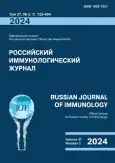Нейроцитокиновый профиль крови ветеранов современных боевых конфликтов с посттравматическим стрессовым расстройством
- Авторы: Пашнин С.Л.1, Давыдова Е.В.1,2, Альтман Д.Ш.1
-
Учреждения:
- ГБУЗ «Челябинская областная клиническая больница»
- ФГБОУ ВО «Южно-Уральский государственный медицинский университет» Министерства здравоохранения РФ
- Выпуск: Том 27, № 2 (2024)
- Страницы: 343-350
- Раздел: КРАТКИЕ СООБЩЕНИЯ
- URL: https://journals.rcsi.science/1028-7221/article/view/263697
- DOI: https://doi.org/10.46235/1028-7221-16669-NBP
- ID: 263697
Цитировать
Полный текст
Аннотация
Формирование постстрессовых расстройств у ветеранов современных боевых конфликтов обусловлено особенностями взаимовлияния психических и иммуно-эндокринных процессов, направленных на поддержание стабильности организма в условиях хронической активации физиологических систем посредством процесса, известного как аллостаз. Целью исследования явилось изучение уровней стресс-медиаторов гипоталамо-гипофизарного и надпочечникового происхождения, показателей цитокинового профиля крови ветеранов современных войн с посттравматическим стрессовым расстройством (ПТСР).
В исследовании приняли участие 38 ветеранов специальной военной операции (СВО) на Украине с диагнозом по МКБ-10: ПТСР (F43.1). Диагноз верифицирован на основании нейропсихологического и патопсихологического обследования. В группу сравнения вошли 30 ветеранов Чеченской военной кампании того же возраста. В крови проводилось определение уровней стрессовых гормонов методом ИФА: АКТГ (тест-система IBL, Германия); норадреналин (Cloud-Clone, Китай); кортизол (ООО «Хема-Медика», Россия); дигидроэпиандростерон (DBC, Канада). Цитокиновый профиль крови определяли при помощи мультиплексного анализа тест-системой Bio-Plex (MERZ, Германия). Сравнение данных проводили с помощью программы Statistica for Windows vers. 10.0.
Свидетельством накопления «аллостатического груза» при формировании ПТСР у ветеранов СВО явилось повышение в крови концентраций АКТГ, норадреналина, кортизола, являющихся пластическими константами кататоксической стратегии адаптации к воздействию пролонгированного боевого стресса. Снижение концентрации дегидроэпиандростерона способствовало развитию психологической дезадаптации и стресс-индуцированных когнитивных расстройств. Аллостатические реакции при ПТСР включали изменение цитокинового профиля крови в виде повышения уровней провоспалительных цитокинов (IL-1β, IL-12 IL-6, TNFα), снижения противовоспалительных и регуляторных цитокинов (IL-4, IL-10, TGF-β, IL-2). Подобный нейровоспалительный статус также может быть связан с развитием психо-поведенческих симптомов ПТСР.
Формирование дезадаптивных изменений при накоплении «аллостатического груза» клинически выражалось в виде ПТСР и сопровождалось изменением нейроцитокинового профиля крови в виде повышения уровней АКТГ, норадреналина, кортизола, IL-lβ, IL-6, IL-12, TNFα, на фоне снижения концентрации дегидроэпиандростерона, TGF-β, IL-4, IL-10, IL-2, что в целом отражает превалирование кататоксической стратегии адаптации у комбатантов СВО.
Ключевые слова
Полный текст
Открыть статью на сайте журналаОб авторах
С. Л. Пашнин
ГБУЗ «Челябинская областная клиническая больница»
Email: davidova-ev.med@yandex.ru
врач-нейрохирург, заслуженный врач РФ, заведующий отделением нейрохирургии
Россия, ЧелябинскЕ. В. Давыдова
ГБУЗ «Челябинская областная клиническая больница»; ФГБОУ ВО «Южно-Уральский государственный медицинский университет» Министерства здравоохранения РФ
Автор, ответственный за переписку.
Email: davidova-ev.med@yandex.ru
д.м.н., доцент, профессор кафедры медицинской реабилитации и спортивной медицины; заведующая отделением ранней медицинской реабилитации
Россия, Челябинск; ЧелябинскД. Ш. Альтман
ГБУЗ «Челябинская областная клиническая больница»
Email: davidova-ev.med@yandex.ru
д.м.н., профессор, заслуженный врач РФ, главный врач
Россия, ЧелябинскСписок литературы
- Альтман Д.Ш., Кочеткова Н.Г., Зурочка А.В., Давыдова Е.В. Темпы биологического старения и маркеры аллостаза у ветеранов афганского конфликта с ранними формами хронической ишемии мозга // Acta Biomedica Scientifica, 2012. № 3 (2). С. 15-18. [Altman D.Sh., Kochetkova N.G., Zurochka A.V., Davydova E.V. Rates of biological aging and markers of allostasis in veterans of the Afghan conflict with early forms of chronic cerebral ischemia. Acta Biomedica Scientifica = Acta Biomedica Scientifica, 2012, no. 3 (2), pp. 15-18. (In Russ.)] mozga (дата обращения: 01.04.2024).
- Крюков Е.В., Шамрей В.К. Военная психиатрия в XXI веке: современные проблемы и перспективы развития. СПб.: СпецЛит, 2022. 367 c. [Kryukov E.V., Shamrey V.K. Military psychiatry in the 21st century: modern problems and development prospects]. St. Petersburg: SpetsLit, 2022. 367 p.
- Севрюкова Г.А. Реостаз, аллостаз и аллостатическая нагрузка: что понимается под этими терминами? / Международный научно-исследовательский журнал, 2022. № 10 (124). [Электронный ресурс]. Режим доступа: https://research-journal.org/archive/10-124-2022. [Sevryukova G.A. Rheostasis, allostasis and allostatic load: what is meant by these terms? Mezhdunarodnyy nauchno-issledovatelskiy zhurnal = International Scientific Research Journal, 2022, no. 10 (124). [Electronic resource]. Access mode: https://research-journal.org/archive/10-124-2022.
- Токарев А.Р. Нейро-цитокиновые механизмы острого стресса (обзор литературы) // Вестник новых медицинских технологий, 2019. № 3. [Электронный ресурс]. Режим доступа: https://cyberleninka.ru/article/n/neyro-tsitokinovye-mehanizmy-ostrogo-stressa-obzor-literatury. [Tokarev A.R. Neurocytokine mechanisms of acute stress (literature review). Vestnik novykh meditsinskikh tekhnologiy = Bulletin of New Medical Technologies, 2019, no. 3. [Electronic resource]. Access mode: https://cyberleninka.ru/article/n/neyro-tsitokinovye-mehanizmy-ostrogo-stressa-obzor-literatury.
- Dutheil F., de Saint Vincent S., Pereira B., Schmidt J., Moustafa F., Charkhabi M., Bouillon-Minois J-B., Clinchamps M. DHEA as a biomarker of stress: a systematic review and meta-analysis. Front. Psychiatry, 2021, no. 12, 688367. doi: 10.3389/fpsyt.2021.688367.
- Foster M.A., Taylor A.E., Hill N.E., Bentley C., Bishop J., Gilligan L.C. Mapping the steroid response to major trauma from injury to recovery: a prospective cohort study. J. Clin. Endocrinol. Metab., 2020, no. 105, pp. 925-937.
- Galic M.A., Riazi K., Pittman Q.J. Cytokines and brain excitability. Front. Neuroendocrinol, 2012, no. 33, pp. 116-125.
- Jiang X., Zhong W., An H., Fu M., Chen Y., Zhang Z. Attenuated DHEA and DHEA-S response to acute psychosocial stress in individuals with depressive disorders. J. Affect. Disord., 2017, no. 215, pp. 118-124.
- McEwen B.S., Gianaros P.J. Central role of the brain in stress and adaptation: links to socioeconomic status, health, and disease. Ann. N. Y. Acad. Sci., 2010, no. 1186, pp. 190-222.
- Swartz J.R., Prather A.A., Hariri A.R. Threat-related amygdala activity is associated with peripheral CRP concentrations in men but not women. Psychoneuroendocrinology, 2017, no. 78, pp. 93-96.
- Quiñones M.M., Maldonado L., Velazquez B., Porter J.T. Candesartan ameliorates impaired fear extinction induced by innate immune activation. Brain Behav. Immun., 2016, no. 52, pp. 169-177.
- Young M.B., Howell L.L., Hopkins L. A peripheral immune response to remembering trauma contributes to the maintenance of fear memory in mice. Psychoneuroendocrinology, 2018, no. 94, pp. 143-151.
- Yu Z., Fukushima H., Ono C. Microglial production of TNF-alpha is a key element of sustained fear memory. Brain Behav. Immun., 2017, no. 59, pp. 313-321.
Дополнительные файлы







